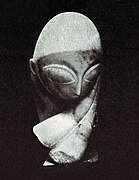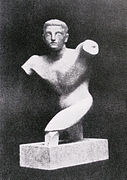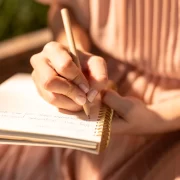
Exposição Internacional de Arte Moderna ou Armory Show foi uma mostra organizada pela Associação de Pintores e Escultores Estadunidenses em 1913. Foi a primeira grande exposição de arte moderna na América, bem como uma das muitas exposições que foram mantidos nos vastos espaços dos arsenais da Guarda Nacional dos EUA.
A exposição em três cidades começou no 69th Regiment Armory da cidade de Nova York, na Lexington Avenue entre 25th e 26th Streets, de 17 de fevereiro a 15 de março de 1913.[1] A exposição foi para o Art Institute of Chicago e depois para The Copley Society of Art in Boston,[2] onde, por falta de espaço, todas as obras de artistas americanos foram retiradas.[3]
A mostra se tornou um evento importante na história da arte americana, apresentando aos americanos estupefatos, acostumados à arte realista, os estilos experimentais da vanguarda europeia, incluindo o fauvismo, o cubismo e o futurismo. O show serviu como um catalisador para artistas estadunidenses, que se tornaram mais independentes e criaram sua própria "linguagem artística".
As origens da mostra estão no surgimento de grupos progressistas e exposições independentes no início do século 20 (com precedentes franceses significativos), que desafiou os ideais estéticos, as políticas de exclusão e a autoridade da Academia Nacional de Design, enquanto expandia a exibição e as vendas oportunidades, aumentando o conhecimento público e ampliando o público para a arte contemporânea.[4]
A exposição original foi um sucesso estrondoso. Houve várias exposições que celebraram o seu legado ao longo do século XX.[5]
Lista de artistas
Abaixo está uma lista parcial dos artistas do show. Esses artistas estão todos listados no catálogo do 50º aniversário como tendo exibido no show Armory original de 1913.[6]
- Robert Ingersoll Aitken
- Alexander Archipenko
- George Grey Barnard
- Chester Beach
- Gifford Beal
- Maurice Becker
- George Bellows
- Joseph Bernard
- Guy Pène du Bois
- Oscar Bluemner
- Hanns Bolz
- Pierre Bonnard
- Solon Borglum
- Antoine Bourdelle
- Constantin Brâncuși
- Georges Braque
- Bessie Marsh Brewer
- Patrick Henry Bruce
- Paul Burlin
- Theodore Earl Butler
- Charles Camoin
- Arthur Carles
- Mary Cassatt
- Oscar Cesare
- Paul Cézanne
- Robert Winthrop Chanler
- Pierre Puvis de Chavannes
- John Frederick Mowbray-Clarke
- Nessa Cohen
- Camille Corot
- Kate Cory
- Gustave Courbet
- Henri-Edmond Cross
- Leon Dabo
- Andrew Dasburg
- Honoré Daumier
- Jo Davidson
- Arthur B. Davies (President)
- Stuart Davis
- Edgar Degas
- Eugène Delacroix
- Robert Delaunay
- Maurice Denis
- André Derain
- Katherine Sophie Dreier
- Marcel Duchamp
- Georges Dufrénoy
- Raoul Dufy
- Jacob Epstein
- Mary Foote
- Roger de La Fresnaye
- Othon Friesz
- Paul Gauguin
- William Glackens
- Albert Gleizes
- Vincent van Gogh
- Francisco Goya
- Marsden Hartley
- Childe Hassam
- Robert Henri
- Edward Hopper
- Ferdinand Hodler
- Jean Auguste Dominique Ingres
- James Dickson Innes
- Augustus John
- Gwen John
- Wassily Kandinsky
- Ernst Ludwig Kirchner
- Leon Kroll
- Walt Kuhn (Founder)
- Gaston Lachaise
- Marie Laurencin
- Ernest Lawson
- Henri de Toulouse-Lautrec
- Arthur Lee
- Fernand Léger
- Wilhelm Lehmbruck
- Jonas Lie
- George Luks
- Aristide Maillol
- Édouard Manet
- Henri Manguin
- Edward Middleton Manigault
- John Marin
- Albert Marquet
- Henri Matisse
- Alfred Henry Maurer
- Kenneth Hayes Miller
- David Milne
- Claude Monet
- Adolphe Monticelli
- Edvard Munch
- Ethel Myers
- Jerome Myers (Founder)
- Elie Nadelman
- Olga Oppenheimer
- Walter Pach
- Jules Pascin
- Francis Picabia
- Pablo Picasso
- Camille Pissarro
- Maurice Prendergast
- Odilon Redon
- Pierre-Auguste Renoir
- Boardman Robinson
- Theodore Robinson
- Auguste Rodin
- Georges Rouault
- Henri Rousseau
- Morgan Russell
- Albert Pinkham Ryder
- André Dunoyer de Segonzac
- Georges Seurat
- Charles Sheeler
- Walter Sickert
- Paul Signac
- Alfred Sisley
- John Sloan
- Amadeo de Souza Cardoso
- Joseph Stella
- Felix E. Tobeen
- John Henry Twachtman
- Félix Vallotton
- Raymond Duchamp-Villon
- Jacques Villon
- Maurice de Vlaminck
- Bessie Potter Vonnoh
- Édouard Vuillard
- Abraham Walkowitz
- J. Alden Weir
- James Abbott McNeill Whistler
- Enid Yandell
- Jack B. Yeats
- Mahonri Young
- Marguerite Zorach
- William Zorach
Lista de mulheres artistas
As mulheres do Armory Show incluíram artistas dos Estados Unidos e da Europa. Aproximadamente um quinto dos artistas eram mulheres, muitas das quais desde então foram negligenciadas.[7]
Imagens
Foto da instalação da sala cubista, publicada no New York Tribune, 17 de fevereiro de 1913 (p. 7). Da esquerda para a direita: Raymond Duchamp-Villon, La Maison Cubiste (Projet d'Hotel), Casa cubista; Marcel Duchamp Nu (Estudo), Jovem Triste em um Trem; Albert Gleizes, L'Homme au Balcon, Homem na Varanda; Marcel Duchamp, Nude Descending a Staircase, No. 2 ; Alexander Archipenko, La Vie Familiale, Family Life
Pintura e escultura selecionadas
Eugène Delacroix, Cristo no Mar da Galiléia, 1854
Honoré Daumier, The Third Class Wagon, 1862-1864
Édouard Manet, The Bullfight, 1866
James Abbott McNeill Whistler, Arranjo em Cinza e Preto: A Mãe do Artista 1871, popularmente conhecido como Mãe de Whistler, Musée d'Orsay, Paris. Embora Whistler fosse representado por quatro pinturas na mostra Armory, isso não foi incluído.
Pierre-Auguste Renoir, In The Garden 1885, Museu Hermitage, São Petersburgo
Mary Cassatt, Mère et enfant (Reine Lefebre e Margot antes de uma janela), c.1902
Georges Seurat, Modelos (Les Poseuses) 1886-88, Barnes Foundation, Filadélfia
Vincent van Gogh, Auto-retrato, c. 1887, óleo sobre tela, 40 x 34 cm (15 ¾ por 13 ⅜ pol.). Museu de Arte Wadsworth Atheneum, Hartford, CT
Vincent van Gogh, Retrato de Adeline Ravoux 1890, Cleveland Museum of Art
Vincent van Gogh, Montanha em Saint-Rémy, 1889, Museu Solomon R. Guggenheim
Albert Pinkham Ryder, Seacoast in Moonlight, 1890, a coleção Phillips, Washington, DC
Paul Gauguin, Palavras do Diabo, 1892, National Gallery of Art, Washington, DC.
Paul Gauguin, Nature morte à l'estampe japonaise (Flores contra um fundo amarelo), 1889, óleo sobre tela, 72,4 × 93,7 cm, Museu de Arte Contemporânea, Teerã
Paul Gauguin, Pastorais do Taiti, (Reo Mā`ohi: Faa iheihe (Fa'ai'ei'e)), 1898, National Gallery emprestado pela Tate
Henri Rousseau, O Centenário da Revolução, 1892
Edvard Munch, Vampiro 1893-94, Nasjonalgalleriet, Oslo
Paul Cézanne, Velha com Rosário, 1895-1896
Paul Cézanne, Baigneuses, 1877-1878
Julian Alden Weir, The Red Bridge, 1895
Claude Monet, Water Lilies and Japanese Bridge, 1897–1899
John Twachtman, Hemlock Pool, c.1900
Henri-Edmond Cross, Cypresses at Cagnes, c.1900
Paul Signac, Port de Marseille, 1905, Metropolitan Museum of Art
Odilon Redon, Le Silence, 1900, pastel, 54,6 × 54 cm, Museum of Modern Art, New York
Odilon Redon, Roger and Angelica, 1910
George Bellows, ambos membros deste clube, 1909
Othon Friesz, Paisagem com Figuras, 1909, óleo sobre tela, 65 × 83 cm
Amadeo de Souza Cardoso, Saut du Lapin, 1911
Amadeo de Souza Cardoso, Avant la Corrida, 1912, óleo sobre tela, 60 × 92 cm, Fundação Calouste Gulbenkian, Lisboa, Portugal
Robert Winthrop Chanler, Leopard and Deer, 1912, guache ou têmpera sobre tela, montado sobre madeira, 194,3 × 133,4 cm, Coleção Rokeby
Patrick Henry Bruce, Still Life, ca. 1912
Ernst Ludwig Kirchner, Naked Playing People, 1910
Wassily Kandinsky, Wassily Kandinsky, Improvisação 27 (Jardim do Amor II), 1912, óleo sobre tela, 47 3/8 x 55 1/4 pol. (120,3 x 140,3 cm), Museu Metropolitano de Arte, Nova York
Maurice Prendergast, Paisagem com figuras, 1913
Robert Henri, Figura em Movimento, 1913
Arthur B. Davies, Mulher Reclinada (Desenho), 1911, Pastel em papel cinza
Robert Delaunay, Window on the City, No. 4, 1910-11 (1912)
Constantin Brâncuși, 1912, Retrato de Mlle Pogany, Museu de Arte da Filadélfia. Postal do Armory Show
Andrew Dasburg, ca. 1912, Lúcifer, gesso, n. 647 do catálogo. Dasburg amplamente retrabalhado ao entalhar diretamente em uma escultura de uma cabeça de gesso em tamanho real por Arthur Lee. (American Studies at the University of Virginia)
Abastenia St. Leger Eberle, 1912–13, The White Slave. Fotografia do The Survey, Journal Publication, Ohio, 3 de maio de 1913
John Frederick Mowbray-Clarke, ca. 1912, Grupo, escultura, postal show de armaria
Wilhelm Lehmbruck, 1911, Femme á genoux (The Kneeling One), pedra fundida, 176 × 138 × 70 cm, cartão postal do Armory Show
Raymond Duchamp-Villon, 1910–11, Torse de jeune homme (Torso de um jovem), terracota, 60,4 cm (23 3/4 pol.), Cartão postal do Armory Show, publicado em 1913. Hirshhorn Museum and Sculpture Garden, Smithsonian Institution, Washington, DC
Jacob Epstein, The Rock Drill, 1913, em sua forma original, agora está perdido.
Antoine Bourdelle, Herakles the Archer, 1909
George Grey Barnard, O Nascimento, c. 1913, mármore
Referências
- ↑ Cotter, Holland (26 de outubro de 2012). «Rethinking the Armory Show (Published 2012)». The New York Times (em English). ISSN 0362-4331. Consultado em 15 de fevereiro de 2021
- ↑ International Exhibition of Modern Art, Copley Society of Boston, Copley Hall, Boston, Mass., 1913
- ↑ Brown, Milton W., The Story of the Armory Show, Joseph H Hirshhorn Foundation, New York, 1963, pp. 185–186
- ↑ Berman, Avis (2000). As National as the National Biscuit Company; The Academy, the Critics, and the Armory Show, Rave Reviews American Art and Its Critics, 1826–1925. [S.l.]: New York: National Academy of Design. 131 páginas
- ↑ 1913 Armory Show 50th Anniversary Exhibition 1963copyright e organizado peloMunson-Williams-Proctor Arts Institute, copyright e patrocinado peloHenry Street Settlement, New York City,Biblioteca do Congressocartão número 63-13993
- ↑ 1913 Armory Show 50th Anniversary Exhibition 1963 copyright and organized by Munson-Williams-Proctor Arts Institute, copyright and sponsored by the Henry Street Settlement, New York City, Library of Congress card number 63-13993
- ↑ Shircliff, Jennifer Pfeifer (2014). Women of the 1913 Armory Show: Their Contributions to the Development of American Modern Art. Louisville, Kentucky: University of Louisville. Consultado em 15 de novembro de 2014
Fontes
- Sarah Douglas. "Pier Pressure." March 26, 2008. Archived on April 11, 2008.
- Catalogue of International Exhibition of Modern Art, at the Armory of the Sixty-Ninth Infantry, Feb 15 to March 15, 1913. Association of American Painters and Sculptors, 1913.
- Walt Kuhn. The Story of the Armory Show. New York, 1938.
- Milton W. Brown. The Story of the Armory Show. Joseph H. Hirshhorn Foundation, distributed by New York Graphic Society, 1963. [republished by Abbeville Press, 1988.]
- 1913 Armory Show 50th Anniversary Exhibition. Text by Milton W. Brown. Utica: Munson-Williams-Proctor Institute, 1963.
- Walter Pach Papers, Archives of American Art, Smithsonian Institution
- Walt Kuhn, Kuhn Family Papers, and Armory Show Records, Archives of American Art, Smithsonian Institution
Links externos
1913 Armory Show
- The Armory Show at 100: Modern Art and Revolution, The New-York Historical Society
- Smithsonian, Archives of American Art, Walt Kuhn scrapbook of press clippings documenting the Armory Show, vol. 2, 1913. Armory Show catalogue (illustrated) from pages 159 through 236
- Catalogue of international exhibition of modern art Association of American Painters and Sculptors. Published 1913 by the Association in New York
- 1913 Armory Show: the Story in Primary Sources, Archives of American Art, Smithsonian Institution
- Virtual re-creation of the Armory Show from the American Studies Programs at the University of Virginia
- Works of art exhibited at the Armory Show of the association of American Painters and Sculptors, New York, Library of Congress
- The Armory Show at 100: Armory Show 1913 Complete List, The New-York Historical Society
Armory mostra depois de 1913
- The "New" Armory Show
- Artkrush.com feature on the 2006 Armory Show (March, 2006)
- 2010 Armory Show
- Swann Galleries – The Armory Show at 100 – Exhibition through November 5, 2013
- Armory Show 2014: List of exhibiting galleries





























































 " class="attachment-atbs-s-4_3 size-atbs-s-4_3 wp-post-image" alt="O que estudar para o enem 2023">
" class="attachment-atbs-s-4_3 size-atbs-s-4_3 wp-post-image" alt="O que estudar para o enem 2023"> " class="attachment-atbs-s-4_3 size-atbs-s-4_3 wp-post-image" alt="Qual melhor curso para fazer em 2023">
" class="attachment-atbs-s-4_3 size-atbs-s-4_3 wp-post-image" alt="Qual melhor curso para fazer em 2023"> " class="attachment-atbs-s-4_3 size-atbs-s-4_3 wp-post-image" alt="Enem: Conteúdos E Aulas On-Line São Opção Para Os Estudantes">
" class="attachment-atbs-s-4_3 size-atbs-s-4_3 wp-post-image" alt="Enem: Conteúdos E Aulas On-Line São Opção Para Os Estudantes"> " class="attachment-atbs-s-4_3 size-atbs-s-4_3 wp-post-image" alt="Como Fazer Uma Carta De Apresentação">
" class="attachment-atbs-s-4_3 size-atbs-s-4_3 wp-post-image" alt="Como Fazer Uma Carta De Apresentação"> " class="attachment-atbs-s-4_3 size-atbs-s-4_3 wp-post-image" alt="Como Escrever Uma Boa Redação">
" class="attachment-atbs-s-4_3 size-atbs-s-4_3 wp-post-image" alt="Como Escrever Uma Boa Redação"> " class="attachment-atbs-s-4_3 size-atbs-s-4_3 wp-post-image" alt="Concurso INSS edital 2022 publicado">
" class="attachment-atbs-s-4_3 size-atbs-s-4_3 wp-post-image" alt="Concurso INSS edital 2022 publicado">


